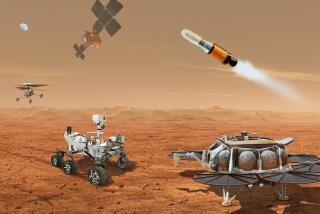Column: As a space exploration target, why does Venus get no love?
- Share via
A whole generation of space scientists are mourning what may be the lost opportunity of a lifetime: Earlier this month, when NASA compiled its roster of planetary probes to be launched over the next six years, Venus was left off the list — again.
According to Paul Voosen of Science Magazine, it could be another decade before NASA again turns its sights on a planet that for a brief time was the most actively explored in the Solar System. Given that the last U.S. probe reached Venus in 1994, that would make for a 30-year gap. “We’re losing a whole generation,” geophysicist Patrick McGovern told Science.
Venus fell off the exploration map for several reasons. Although it’s Earth’s closest planetary neighbor — 25.7 million miles away, or roughly half the distance to Mars — it’s shrouded in thick clouds, obscuring features that might have inspired interest. That also makes dropping half-billion-dollar probes to the surface more of a crapshoot than flying by objects without atmospheric interference, such as asteroids that will be targeted in the two missions that got NASA’s green light on Jan. 4.
I could see in that one image that there was something really strange about Venus.
— Astrobiologist David Grinspoon, referring to the “Crater Farm”
In this century, Mars has overtaken Venus as an object of Earthbound curiosity. The last U.S. Venus mission was Magellan, which used radar technology to map the surface. (See image above.) Magellan was launched from the space shuttle Atlantis in 1989 and burned to a crisp in the Venusian atmosphere, its work completed, in October 1994.
Mars missions continue to proliferate, driven in part by the dream of colonization. (Elon Musk, we’re talking about you). Conditions on Venus are pitiless, with a mean surface temperature estimated at 863 degrees Fahrenheit. On Mars, the temperature on the equator at noon can reach a balmy 68 degrees. Astronaut Mark Watney of “The Martian” wouldn’t last seconds on Venus before being vaporized.
Yet Venus experts say there’s a lot to learn from their mysterious quarry. There are signs that the Venusian atmosphere bears enough similarity to Earth’s to suggest the planets were primordial cousins, even twins. There may be active volcanoes on the surface. Venus scientists say the few details they’ve gleaned about the planet’s surface from NASA radar imaging and pictures from the Soviet Venera probes of the 1970s and 1980s leave them thirsting for more.
“I remember when I first laid my eyes on a press release image from early on in the Magellan mission of an area informally called the ‘Crater Farm,’ ” recalls astrobiologist David Grinspoon, of the Denver Museum of Nature and Science, on NASA’s website. “I could see in that one image that there was something really strange about Venus…. I remember looking at that picture and thinking that there is something weird going on here and that it has important implications for the whole history of the planet, its climate, its atmosphere, its geology. And I still think that that is true.”
Most intriguing, there are indications that the Venusian atmosphere is the product of a “runaway greenhouse effect,” Voosen reports. Understanding what happened could be relevant to research into climate change here on Earth. Of course, given the hostility in a climate change-denying Congress to research by NASA that bears any relevance to Earth science, that could be exactly the wrong pitch for funding just now.
Venus science is yet another victim of congressional budget-cutting that seeks to put a leash on scientific curiosity. U.S. scientists, and American scholarship, are the real losers.
There’s still hope, Science reports. Venus is one of the targets in the running for NASA’s upcoming New Frontiers mission, which will be open to proposals until the end of April. There’s a possibility that NASA could partner with the Russians for a revived Venera program, which would allow the Russians to relive their brief moment of space exploration supremacy while allowing NASA some relief from stringent budget limitations. And then there’s the lure of novelty: It’s been so long since Venus has been an object of interest, shouldn’t it again have its day in the sun?
Keep up to date with Michael Hiltzik. Follow @hiltzikm on Twitter, see his Facebook page, or email [email protected].
Return to Michael Hiltzik’s blog.







